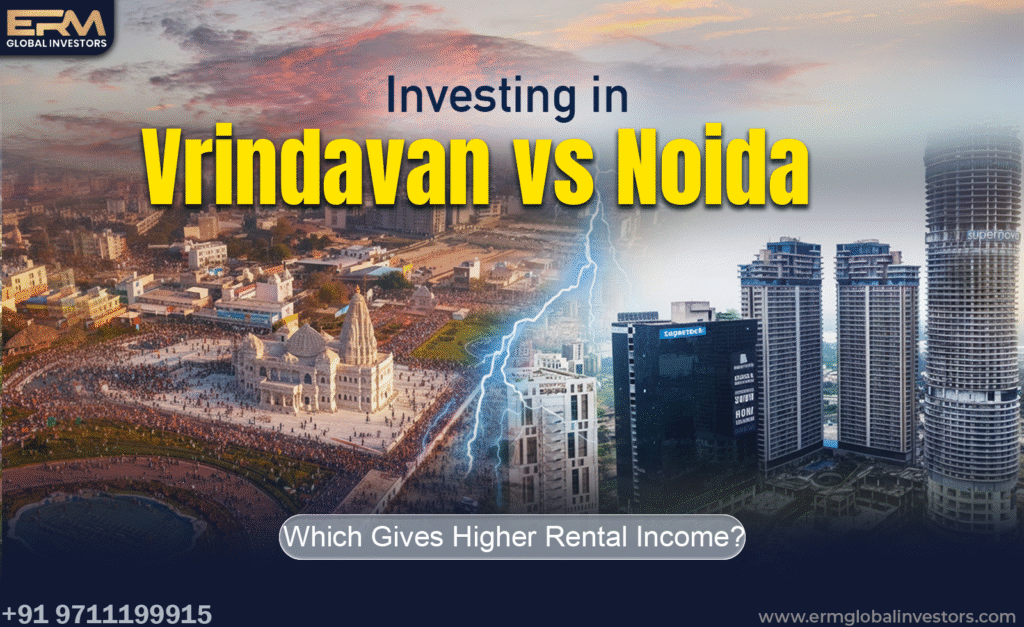Introduction
Property investment is always a question of weighing cost, location, demand, and growth potential. If you are considering plots available from ERM Global Investors, two of their most well-known premises plots in Vrindavan and Noida (Sector 76). Let’s compare them on different parameters and then determine which one could potentially offer you more rental income, on what conditions.
Overview of the Properties
Demand Drivers that Affect Rental Income
In order to estimate rental income potential, you have to consider what types of rentals there will be in each place and what the demand is like.
Vrindavan
- Spiritual / Religious Tourism: Vrindavan is a pilgrimage town. Pilgrims, devotees, tourists daily—this creates demand for lodges, homestays, guest houses, and shops around temples.
- Serenity & Second Home / Retreats: Certain investors purchase land here as second homes for personal retreats or seasonal retreats. While such use generates lesser steady rental income, but can command premium rates during holiday/festival seasons.
- Infrastructure & Connectivity is getting better: Being close to Yamuna Expressway, decent roads (24m Mant Road), connectivity to Mathura, Agra, etc.
Noida (Sector 76)
- Urban Demand: Noida is in NCR; high demand for homes, commercial, and mixed-use. Ongoing development of infrastructure, services, offices, schools, hospitals, etc.
- Commercial / Residential Hybrid: As mixed-use (residential + commercial) plots are allowed, these may be constructed for shops, small offices, etc. Greater rental yields are available from Noida commercial plots occupants than from pure residential.
- Improved Continuous Rentability: In Noida, due to population density, people will rent long-term, whereas in Vrindavan, there will be some rentals more seasonal.
Cost vs Return: Which Has Better Rental Yield?
Rental Yield = (Annual rent) ÷ (Price you paid) – this relies greatly on how much you can charge for rent, what use you do (homestay, shop, office, etc.), and how regularly the place is used.
Let’s do a rough comparison, using examples, to see what’s plausible.
Sample Scenarios
Scenario | Vrindavan Plot (100 yd) | Noida Plot (say 120 yd) |
Cost of Plot | 120 yd × ₹2,10,000 = ₹2,52,00,000 | |
Possible Rental Use | Guest house / homestay / PG / shops near temple | Residential + shops / small offices / high-end tenant usage |
Estimated Annual Rent (very approximate) | If built for a guest house or multiple lodgings: say you can get ₹3,00,000–₹5,00,000 per year, depending on occupancy, season etc. | For commercial + residential use, may get ₹12,00,000–₹20,00,000+ per year (depending on build, location, tenant). |
Approximate Yield | 6-10% per annum (depending on how well you rent, occupancy etc.) | ~ 5-8% or possibly somewhat lower if plot price is very high, unless usage is premium commercial or you build well. |
These are rough, illustrative numbers. Actual results depend on build cost, operation cost, maintenance, occupancy, local laws, etc.
Advantages vs Challenges: Vrindavan & Noida
Benefit | Vrindavan | Noida |
Lower entry cost | Yes – the plot prices are significantly lower per yard compared to Noida. | Higher cost, so larger capital is required upfront. |
Seasonal high demand | Festivals, pilgrimage seasons can push up demand and rent. | More stable year-round demand but less spike benefit. |
Commercial potential | Near temples, heritage spots – small shops, guest houses etc. | More varied – shops, offices, mixed use, better infrastructure and better access. |
Connectivity & appreciation potential | Growing, especially with the Expressway, nearby projects (e.g. Raya Heritage City), infrastructure improvements. | Already comparatively more developed infrastructure, better connectivity in many ways. |
Challenges:
- Vrindavan: Seasonality (rental income can be variable), potentially lower per sq. ft or per sq. yd rent during off-season, lack of proximity to large urban areas; has to ensure legal clearances, etc.
- Noida: More expensive, greater competition, greater expectations (quality of construction, amenities), potentially greater maintenance and cost of construction; also longer time to locate profitable commercial tenants.
Which Gives Higher Rental Income? Verdict
If maximum rental earnings (in absolute terms) is your aim, Noida Sector 76 plots have an advantage because:
- Ability to construct commercial or mixed-use buildings that attract higher rents per sq. ft./yard.
- Greater demand base of long-term tenants (homes + offices + shops) as opposed to predominantly seasonal / pilgrimage-based demand.
But if we look at rental yield (return on investment), Vrindavan could beat you if you develop well:
- Since the cost per plot is significantly less, your initial investment is lower.
- If you are able to catch the pilgrimage/tourism demand well (shops, guest houses, short stay rentals) and maintain good occupancy, your return can be high.
- For consistent, large-scale rent income, Noida is secure and most probably provides higher overall rental returns.
- For a higher return, lower cost with scope for growth, Vrindavan is compelling if you are willing to take slightly more risk or volatility.
What to Do to Maximize Rental Income
To make sure whatever you do provides you with good returns:
- Create appropriately: homestays/guest houses in Vrindavan; in Noida, mixed-use with commercial front, possibly small rental housing + retail.
- Offer proper infrastructure, amenities, and connectivity to induce tenants.
- Legal clearances: free titles, consent for commercial/residential use; for Vrindavan, ensure all the licenses, etc (no surprise costs).
- Maintenance, occupancy: control expenses, reduce idle time.
Conclusion
Both Noida and Vrindavan have good prospects for investment, but it is a decision based on your objectives. Vrindavan plots are reasonably priced and provide better percentage yields, particularly in the form of temple tourism-driven rentals like shops, PGs, and guest houses. Noida plots are more expensive but give stable and sure-shot family, professional, and business rentals along with good appreciation potential in the long term.
If your priority lies in low entry and high return, Vrindavan is the better choice. If you desire regular monthly returns and long-term appreciation, Noida is the intelligent choice. For most investors, a mix of investing in both can optimize returns with the minimization of risk.


